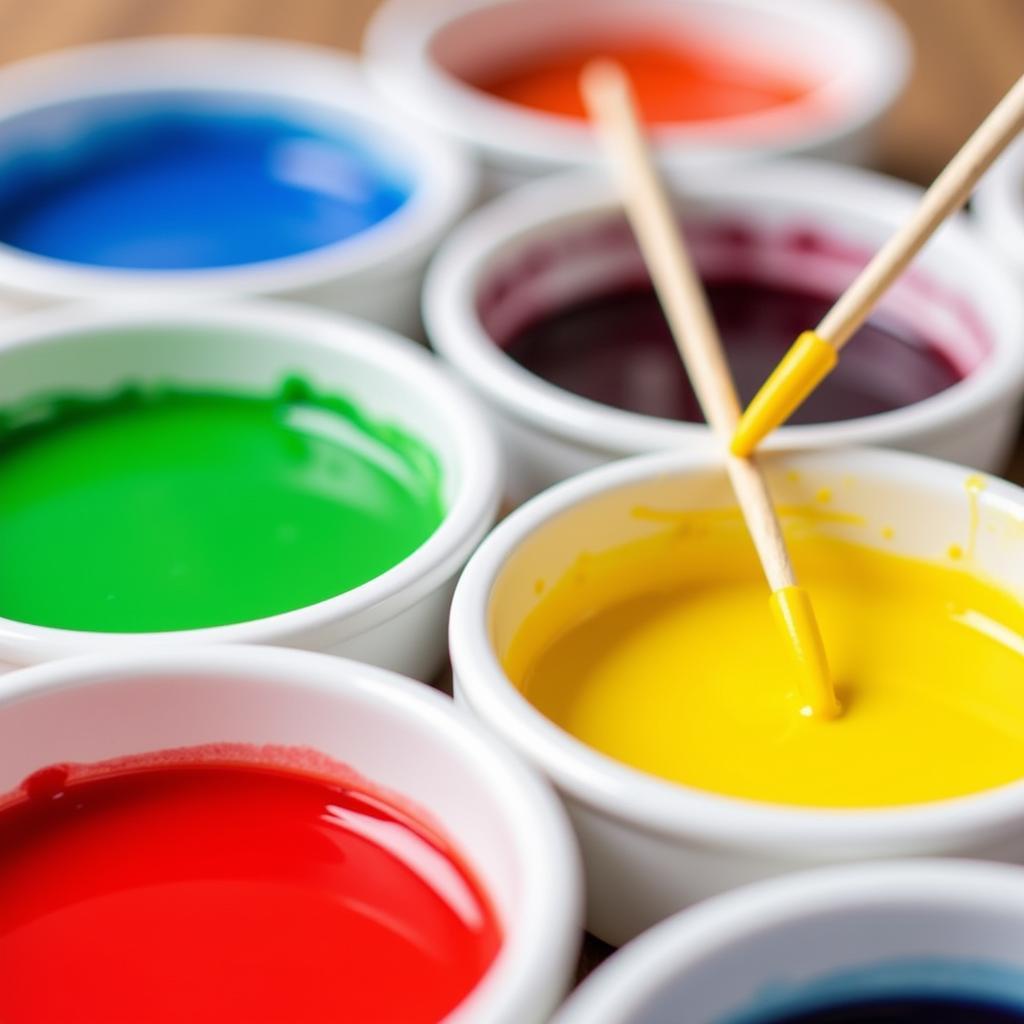Want to add a pop of color to your culinary creations? Learning How To Make Different Colors With Food Coloring opens up a world of vibrant possibilities, from frosting masterpieces to colorful cake batters. Whether you’re a seasoned baker or a curious beginner, this guide will equip you with the knowledge to transform ordinary food coloring into a rainbow of hues.
Understanding the Basics of Food Coloring
Before we dive into mixing, let’s cover the fundamentals. Food coloring typically comes in liquid or gel form, with gel colors being more concentrated. The primary colors – red, blue, and yellow – are your building blocks, allowing you to create an array of secondary and tertiary colors.
Essential Tools for Color Mixing
Having the right tools makes the color mixing process smoother and more enjoyable. Here’s what you’ll need:
- Small bowls or containers: These will hold your individual colors and mixtures.
- Toothpicks or skewers: Use these for adding small amounts of color and mixing.
- White base: This could be frosting, icing, batter, or any other food you want to color.
- Color chart (optional): A color chart can be a handy reference, especially when you’re starting out.
Mastering the Art of Color Mixing
Creating your desired shades is all about ratios and understanding how colors interact. Here’s a step-by-step guide:
- Start with a white base: A white base ensures the colors appear vibrant and true.
- Begin with a small amount of coloring: Always add color gradually, as a little goes a long way.
- Mix thoroughly: Use your toothpick or skewer to combine the colors completely, ensuring an even distribution.
- Adjust as needed: If the color isn’t intense enough, add more coloring drop by drop. If it’s too dark, add a bit more of your white base.
Creating a Rainbow of Colors: Tried and True Recipes
Let’s explore how to achieve specific colors using primary food coloring:
How to Make Green Food Coloring
Green is a snap to create! Combine equal parts blue and yellow food coloring, gradually adding more of either color to fine-tune your shade.
How to Make Purple Food Coloring
Purple emerges beautifully by mixing red and blue. For a bluer purple, use more blue than red. For a redder hue, increase the red.
How to Make Orange Food Coloring
Achieving a vibrant orange involves mixing red and yellow. To enhance the reddish tones, add more red. For a yellower orange, use more yellow.
How to Make Brown Food Coloring
While brown might not be a primary color, it’s just as simple to achieve. Combine all three primary colors – red, blue, and yellow – to create a rich brown. Adjust the ratios to achieve different shades, such as a lighter tan or a deeper chocolate.
 Mixing Food Coloring in Bowls
Mixing Food Coloring in Bowls
Tips and Tricks for Perfect Food Coloring Every Time
Here are some expert tips to elevate your food coloring game:
- Gel vs. Liquid: Gel colors tend to be more concentrated, resulting in more vibrant hues and less alteration of your food’s texture.
- Black Food Coloring: While you can mix all primary colors to get close to black, using pre-made black food coloring will yield a truer, richer black.
- Natural Food Coloring: For a natural approach, explore options like beet juice (pink/red), turmeric (yellow), and spinach puree (green).
- Color Fading: Some colors, especially red and purple, might fade slightly over time. Consider coloring your creations closer to serving to maintain vibrancy.
- Practice Makes Perfect: Don’t be afraid to experiment! The more you practice, the more confident you’ll become in creating the perfect shades.
“When it comes to food coloring, remember that less is more,” advises renowned pastry chef, Emily Carter. “Start with a tiny amount and gradually build up the color until you achieve your desired shade. This approach prevents over-coloring and ensures vibrant, appealing results.”
Conclusion
Learning how to make different colors with food coloring empowers you to infuse your culinary creations with personality and flair. By understanding basic color theory, gathering the right tools, and following these simple steps, you’ll be well on your way to transforming ordinary treats into colorful masterpieces. So go forth, unleash your inner artist, and let your creativity shine through a spectrum of edible hues!
FAQs
1. Can I use liquid watercolors as food coloring?
No, liquid watercolors are not safe for consumption and should not be used as food coloring.
2. How do I avoid streaks of color in my frosting?
Ensure your food coloring is fully incorporated into your frosting by mixing thoroughly. A toothpick can help reach the edges of your bowl for complete blending.
3. What should I do if I add too much food coloring?
If you accidentally add too much coloring, you can try to salvage your mixture by adding more of your white base. If the color is beyond saving, start over with a fresh batch.
4. Can I mix different brands of food coloring?
Yes, you can generally mix different brands of food coloring. However, keep in mind that color concentrations may vary, so it’s always best to test a small amount first.
5. Where can I find inspiration for color combinations?
Look to nature, artwork, or even fashion for inspiration. The possibilities are endless!
For more in-depth guides on specific color combinations, check out our other helpful resources:
- How to Mix Food Coloring to Make Different Colors
- What Color Purple and Red Make
- How to Make Flesh Colored Fondant
- How to Make Cream Colored Icing
- Does Food Coloring Have a Taste
Need further assistance in your color mixing journey? Don’t hesitate to reach out! Contact us at Phone Number: 0373298888, Email: [email protected] Or visit us at: 86 Cầu Giấy, Hà Nội. Our dedicated customer support team is available 24/7 to assist you.